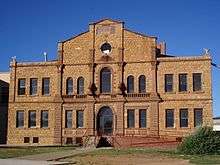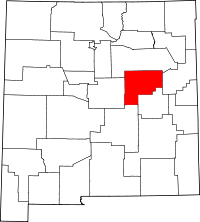Santa Rosa, New Mexico
| Santa Rosa, New Mexico | |
|---|---|
| City | |
|
New wing, Guadalupe County Courthouse | |
 Location of Santa Rosa, New Mexico | |
 Santa Rosa, New Mexico Location in the United States | |
| Coordinates: 34°56′32″N 104°41′2″W / 34.94222°N 104.68389°WCoordinates: 34°56′32″N 104°41′2″W / 34.94222°N 104.68389°W | |
| Country | United States |
| State | New Mexico |
| County | Guadalupe |
| Area | |
| • Total | 4.3 sq mi (11.1 km2) |
| • Land | 4.2 sq mi (11.0 km2) |
| • Water | 0.0 sq mi (0.1 km2) |
| Elevation | 4,616 ft (1,407 m) |
| Population (2000) | |
| • Total | 2,744 |
| • Density | 645.7/sq mi (249.3/km2) |
| Time zone | Mountain (MST) (UTC-7) |
| • Summer (DST) | MDT (UTC-6) |
| ZIP code | 88435 |
| Area code(s) | 575 |
| FIPS code | 35-70670 |
| GNIS feature ID | 0918353 |

Santa Rosa is a city in and the county seat of Guadalupe County, New Mexico, United States.[1] The population was 2,744 at the 2000 census. It lies between Albuquerque and Tucumcari, situated on the Pecos River at the intersection of Interstate 40, U.S. Route 54, and U.S. Route 84. The city is located west of, but not within, the Llano Estacado or "staked plains" of eastern New Mexico and west Texas.
History
The first Euro-American settlement in the area was Aqua Negra Chiquita, "Little Black Water" in Spanish, in 1865. The name was changed in 1890 to Santa Rosa (Spanish for "Saint Rose") referring to a chapel that Don Celso Baca (the founder of the city) built and named after both his mother Rosa and Saint Rose of Lima. The "Rosa" may also refer to the roses in the story of Our Lady of Guadalupe and is indicative of the Catholicism of the Spanish colonizers who settled in the area.
Santa Rosa was connected by railroad to Chicago, El Paso, and the world at large in the early 1900s.
Santa Rosa's stretch of U.S. Route 66 is part of film history. When John Steinbeck's epic novel, The Grapes of Wrath, was made into a movie, director John Ford used Santa Rosa for the memorable train scene. Tom Joad (Henry Fonda) watches a freight train steam over the Pecos River railroad bridge, into the sunset. It was also one of shooting scenes for Bobbie Jo and the Outlaw starring Lynda Carter in the titular role.
The town was the childhood home of author Rudolfo Anaya, and is the basis for the fictional town of Guadalupe in his autobiographical novel Bless Me, Ultima.
Geography
Santa Rosa has many natural lakes, an anomaly in the dry Desert climate surrounding it. These are sinkholes that form in the limestone bedrock of the area and fill with water, and thus the lakes are connected by a network of underground, water-filled tunnels. The most famous of these is Blue Hole, a popular spot for diving, where cool 61 °F (16 °C) water forms a lake over 81 ft (25 m) deep.
Santa Rosa is located at 34°56′32″N 104°41′2″W / 34.94222°N 104.68389°W (34.942166, -104.683981).[2]
According to the United States Census Bureau, the city has a total area of 4.3 square miles (11 km2), of which, 4.2 square miles (11 km2) of it is land and 0.04 square miles (0.10 km2) of it (0.70%) is water.
Demographics
| Historical population | |||
|---|---|---|---|
| Census | Pop. | %± | |
| 1920 | 1,093 | — | |
| 1930 | 1,127 | 3.1% | |
| 1940 | 2,310 | 105.0% | |
| 1950 | 2,199 | −4.8% | |
| 1960 | 2,220 | 1.0% | |
| 1970 | 2,485 | 11.9% | |
| 1980 | 2,469 | −0.6% | |
| 1990 | 2,263 | −8.3% | |
| 2000 | 2,744 | 21.3% | |
| 2010 | 2,848 | 3.8% | |
| Est. 2015 | 2,675 | [3] | −6.1% |
As of the census[5] of 2000, there were 2,744 people, 898 households, and 616 families residing in the city. The population density was 645.7 people per square mile (249.3/km²). There were 1,024 housing units at an average density of 241.0 per square mile (93.0/km²). The racial makeup of the city was 57.47% White, 2.19% African American, 1.75% Native American, 0.87% Asian, 0.04% Pacific Islander, 33.13% from other races, and 4.56% from two or more races. Hispanic or Latino of any race were 81.16% of the population.
There were 898 households out of which 35.0% had children under the age of 18 living with them, 45.1% were married couples living together, 18.3% had a female householder with no husband present, and 31.3% were non-families. 28.0% of all households were made up of individuals and 11.2% had someone living alone who was 65 years of age or older. The average household size was 2.50 and the average family size was 3.03.
In the city the population was spread out with 23.1% under the age of 18, 10.4% from 18 to 24, 34.4% from 25 to 44, 20.0% from 45 to 64, and 12.0% who were 65 years of age or older. The median age was 36 years. For every 100 females there were 135.1 males. For every 100 females age 18 and over, there were 145.2 males.
The median income for a household in the city was $25,085, and the median income for a family was $28,782. Males had a median income of $20,161 versus $16,417 for females. The per capita income for the city was $11,168. About 18.9% of families and 23.2% of the population were below the poverty line, including 27.5% of those under age 18 and 23.9% of those age 65 or over.
Sports
Santa Rosa High School's football team won back-to-back-to-back state championships in the 2010, 2011, and 2012 AA state championships. The 2010 and 2011 victories were won against teams which were undefeated until the championship. In 2010 the Santa Rosa Lions beat the Tularosa Wildcats, and in 2011 the Santa Rosa Lions beat the Eunice Cardinals. In 2012, the Santa Rosa Lions went undefeated, shutting out the Tularosa Wildcats in the championship. The Lions also won championships in 1955, 1993, 1996, 1998, and 2007.[6]
References
- ↑ "Find a County". National Association of Counties. Retrieved 2011-06-07.
- ↑ "US Gazetteer files: 2010, 2000, and 1990". United States Census Bureau. 2011-02-12. Retrieved 2011-04-23.
- ↑ "Annual Estimates of the Resident Population for Incorporated Places: April 1, 2010 to July 1, 2015". Retrieved July 2, 2016.
- ↑ "Census of Population and Housing". Census.gov. Retrieved June 4, 2015.
- ↑ "American FactFinder". United States Census Bureau. Retrieved 2008-01-31.
- ↑ "New Mexico State Football Champions" (PDF).
Further reading
- Wiley, Olive Smith (1973). - A Santa Rosa Story. - 2959604
External links
| Wikimedia Commons has media related to Santa Rosa, New Mexico. |
| Wikivoyage has a travel guide for Santa Rosa, New Mexico. |

